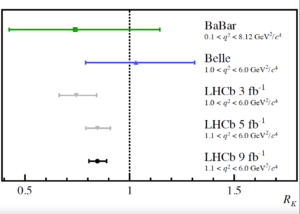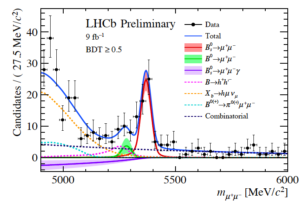The LHCb experiment at CERN might be seeing a glimpse of new physics. The experiment has found a serious indication in its measurements that electrons and their heavier counterparts muons respond not exactly identical to forces.
That would mean that the current theory of the particle world falls short and may involve an unknown additional force.
The measurements are solid enough for “cautious excitement” among physicists, but statistically there is no sign yet of the discovery of anything new, the LHCb researchers say. Nikhef is closely involved in the LHCb work.
The results were presented at a CERN seminar on March 23. A second remarkable result was also reported there, observations of the rarest decay process ever seen of so-called B mesons. The particle processes are observed by LHCb during collisions of protons in the LHC accelerator at CERN.

According to the Standard Model of the particle world, their mass is the only difference between electrons and muons. A muon is about 200 times heavier than an electron. The theory further states that there is lepton universality, meaning that different types of leptons feel identical forces.
The decay of B mesons via so-called ‘penguin’ processes to Kaon particles, together with muons on the one hand or electrons on the other, is a highly sensitive method to test this universality. The measurement is expressed in a quantity R_K, the number of B decays to muons divided by the number of decays to electrons.
Deviation of 3.1 sigma
Where the Standard Model expects a value of R_K = 1, the result found by LHCb is R_K = 0.846 + 0.044 – 0.041. This corresponds to a deviation of 3.1 sigma from the expectation of the Standard Model. This is an indication that the forces of nature are not equal for electrons and muons. This may also be an indication of the existence of yet another unknown fifth force of nature.
The new measurement is the result of all the data collected by LHCb in run-1 and run-2 of the LHC. The measurement was carried out by an international team of researchers led by the LHCb physics coordinator Niels Tuning from Nikhef.
During the research period, the entire measurement procedure was tested for imperfections for months by a team of three prominent LHCb reviewers, including Wouter Hulsbergen from Nikhef.
The reviewers turned over every stone in the analysis, Hulsbergen says of it, “I’m quite critical by nature, but it seems to be watertight.”
The fact that the deviation is just beyond the statistical limit of 3 sigma means, according to the agreements within the field, that there may be an indication (“evidence”) for a deviation from the Standard Model.
Only with a deviation beyond 5 sigma is there talk of a definitive observation. For this reason there is now talk of “cautious excitement” within the CERN community.
Nikhef researcher Niels Tuning: “The exciting thing about such a deviation is that it can still go either way: is the result moving towards the Standard Model, or towards a discovery, if a second measurement is added later this year?”
Rarest decay
The second result made public on Tuesday is a new measurement of the very rare decay process of a Bs meson to two muons, also using the data of the full Run-2. Since only two muons are released in this process, this quantum process is even more suppressed than the above penguin processes; we speak of a “very rare decay”.

The result found is BR (Bs -> ??) = 3.09 + 0.48 – 0.44 x 10^(-9). Only one in three billion Bs mesons decays to two muons. This makes it the rarest decay ever measured at the LHC, and at the same time a process that is very sensitive to potential contributions from yet undiscovered quantum particles.
In addition, the similar but even rarer decay of B0 particles to two muons was also searched for. The value found for this is 1.2 + 0.8 – 0.7 x 10^(10). Statistically this is not yet sufficient to be called “evidence”.
The investigation of the very rare B decays includes contributions from Nikhef/Maastricht University researchers Silvia Ferreres and Jacco de Vries, in collaboration with CERN Fellow Mick Mulder.
De Vries: “In order to measure such a rare decay, all steps of the analysis must be carefully calibrated – we have been working on that for the last few years.”
Mick Mulder: “With the improved measurement of this very rare decay we are doing a precise test of our Standard Model that tells us more about the possible new particles that contribute to the universality test.”
Silvia Ferreres: “Two years of hard work on the calibrations was totally worth it! That we put all the pieces of the puzzle together and then see such a wonderful result is a dream come true.”
New particles
Because of the now published measurements, there is an air of “cautious excitement” among researchers about the possible disparity of electrons and muons. Further confirmation is needed before there can be any talk of an actual breakthrough.
Several analyses are underway in the LHCb experiment that may provide confirmation of the deviation from the standard model in the spring. Ultimately, it is important that the measurements are also confirmed by other experiments. In addition to the LHCb experiment, CMS and ATLAS are also in the race and soon the Belle II experiment in Japan will be as well.
If these measurements are confirmed, it also means that there is a new force of nature in addition to the four known fundamental forces. The special feature of this new natural force is that it distinguishes between the different leptons.
A combination of all kinds of different measurements, including R_K and Bs -> ?? will then map out the characteristic properties of such a natural force, conveyed by a new quantum particle.
In addition to the above measurements, other long-awaited measurements are in the pipeline, most notably the so-called R_D measurement that tests the universality of electrons and muons with tau particles. Current data point in the direction that the new force occurs most strongly with these third generation tau particles. This new force could then possibly have played an important role in the early universe.
Marcel Merk, programme leader of the LHCb project at Nikhef and professor of particle physics at Maastricht University, calls the current developments super exciting: “On 21 January this year the analysts were shown the data for the first time. I received two messages from Mick Mulder shortly after: “0.85” and “more than 3 sigma”. My heart jumped. Wow, this is it, I thought: this is the reason I started research with LHCb 25 years ago.”